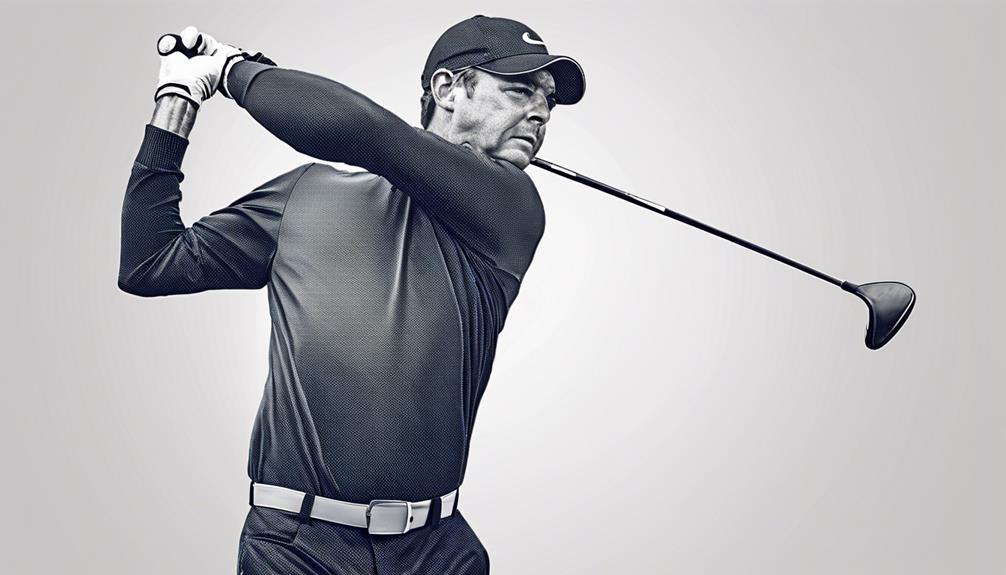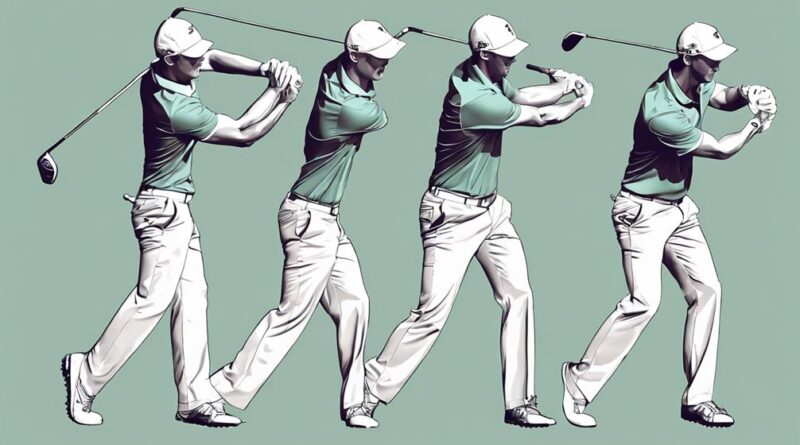10 Best Insights Into Pro Golf Swing Biomechanics
Mastering the intricate biomechanics of a pro golf swing demands understanding swing plane dynamics, launch angle optimization, and precise energy transfer mechanisms. Efficiently moving body parts in a sequential order, such as hip rotation and weight transfer, is key. Shoulder and hip movements generate power and stability, enhancing the kinetic chain function. Weight shift optimization, torque generation, and mastering lag and release for club acceleration are crucial. Wrist angles, muscle activation, and smooth power transition further optimize swing efficiency. Delve deeper into the nuances of pro golf swing biomechanics to elevate your game to elite standards.
Biomechanics of the Golf Swing
Understanding the biomechanics of the golf swing is essential for optimizing performance and preventing injuries among players of all skill levels. When examining the swing mechanics, one crucial aspect to consider is the swing plane dynamics. The swing plane refers to the imaginary surface formed by the club's motion as it swings through the ball. Maintaining the correct swing plane throughout the swing is vital for consistent ball striking and accuracy. Deviations in the swing plane can lead to mis-hits and inconsistent shots.
Another key factor in the biomechanics of the golf swing is the launch angle. The launch angle directly affects the trajectory and distance of the ball. Achieving the optimal launch angle requires a combination of proper clubface orientation, swing speed, and angle of attack. Understanding how these variables interplay is fundamental for maximizing distance and control.
Muscle activation plays a significant role in executing a powerful and precise golf swing. Different muscles are engaged at various stages of the swing to generate speed and transfer energy efficiently from the body to the club. The sequence of muscle activation is crucial for a synchronized and efficient swing. Developing strength and flexibility in the muscles involved in the golf swing can improve performance and reduce the risk of injuries. By honing in on these biomechanical aspects, players can enhance their skills and elevate their game to new heights.
Kinematic Sequence in Golf
To further dissect the mechanics of the golf swing, let's explore the intricate Kinematic Sequence in Golf. The kinematic sequence is a crucial aspect of the golf swing that involves the precise coordination of body movements to generate power and accuracy in your shots. Understanding this sequence can greatly enhance your performance on the course.
Swing plane analysis and timing accuracy are fundamental components of the kinematic sequence. The efficient movement of your body parts in a sequential order plays a significant role in achieving a consistent and powerful swing. Proper sequencing ensures that energy is transferred effectively from the ground up through your body to the club, resulting in a more controlled and powerful shot.
Hip rotation and weight transfer dynamics are key elements of the kinematic sequence. The sequence typically starts with the hips rotating, followed by the torso, arms, and finally the club. This sequential unwinding of body segments allows for the generation of maximum clubhead speed at the point of impact. Additionally, the transfer of weight from the back foot to the front foot during the downswing is essential for maintaining balance and generating power.
Impact of Body Rotation
Body rotation in the golf swing is a fundamental element that significantly influences the power and accuracy of your shots. The coordination between shoulder rotation, hip movement, spinal rotation, and weight shift is crucial for a successful swing.
Shoulder rotation plays a key role in generating clubhead speed and power. As you initiate the downswing, your lead shoulder should rotate downward and around, allowing you to maintain a proper swing plane and generate torque. This movement helps in storing energy that can be efficiently transferred to the clubhead upon impact.
Simultaneously, proper hip movement is essential for generating power and maintaining balance throughout the swing. Your hips should initiate the downswing by rotating open towards the target, allowing for a sequential transfer of energy from the lower body to the upper body. This movement not only adds power to your swing but also helps in maintaining control and stability.
Spinal rotation is another critical component of body rotation in the golf swing. As you rotate your shoulders and hips, your spine acts as the connecting link, ensuring that the kinetic chain functions efficiently. Proper spinal rotation allows for a smooth transfer of energy from the ground up, resulting in a more powerful and accurate shot.
Additionally, a well-executed weight shift towards the target foot ensures that your body's center of gravity is properly aligned, optimizing your swing mechanics for maximum performance.
Power Transfer Mechanics
Efficient power transfer in your golf swing hinges on precise coordination of kinetic energy from the lower body to the upper body. To achieve this, mastering weight distribution and timing is crucial. As you start your downswing, ensure that your weight shifts smoothly from the back foot to the front foot. This transfer of weight initiates the sequence of movements that generate power in your swing. Timing is key here; the shift should happen at the right moment to optimize the transfer of energy.
Hip rotation plays a significant role in power transfer mechanics. As you rotate your hips towards the target during the downswing, you store energy that can be unleashed as you swing through the ball. It's essential to maintain stability in your lower body while allowing your hips to rotate freely. This stability ensures that the energy generated from the lower body is effectively transmitted to the upper body, maximizing the power of your swing.
Incorporating proper hip rotation and stability with precise weight distribution and timing creates a chain reaction of energy transfer that culminates in a powerful golf swing. Remember, mastering these power transfer mechanics can significantly impact the distance and accuracy of your shots.
Clubhead Speed Analysis
Analyzing clubhead speed is a critical component of evaluating the effectiveness and efficiency of your golf swing mechanics. Clubhead speed is influenced by various factors, including launch angle optimization and swing plane dynamics. Achieving an optimal launch angle ensures that the ball travels the farthest distance possible while maintaining accuracy. Understanding swing plane dynamics helps in generating the necessary speed to achieve this optimal launch.
When it comes to clubhead speed analysis, grip pressure influence plays a significant role. The pressure exerted on the grip affects how efficiently energy is transferred from your body to the clubhead. Finding the right balance in grip pressure is crucial for maximizing clubhead speed.
Moreover, swing path mechanics are essential in determining the speed at which the clubhead travels through impact. A proper swing path that's on plane allows for maximum acceleration and speed generation. Deviations from the ideal path can result in decreased clubhead speed and accuracy.
Role of Ground Reaction Forces
To optimize clubhead speed and enhance swing mechanics, a deep understanding of how ground reaction forces influence your golf swing is paramount. Ground force optimization is crucial in generating power and stability throughout your swing. When you address the ball, your feet exert force into the ground. As you initiate the backswing, this force is stored in your muscles and tendons, ready to be unleashed during the downswing.
Efficiently transferring this stored energy back into the ground through your feet as you rotate your hips and shift your weight towards the target is key to a powerful and stable swing.
Swing stability strategies play a vital role in utilizing ground reaction forces effectively. Ensuring a solid connection with the ground throughout your swing helps maintain balance and control. Proper weight shift from back foot to front foot during the downswing allows you to leverage the ground for added power.
Engaging your lower body and core muscles to push against the ground while rotating generates torque, enhancing the speed and accuracy of your swing. By optimizing how you interact with the ground, you can create a more efficient and powerful golf swing. Mastering these ground reaction forces won't only increase your clubhead speed but also improve the consistency and overall performance of your golf game.
Torque Generation in the Swing

When generating torque in your golf swing, the key lies in effectively engaging your lower body and core muscles to push against the ground while rotating. To optimize torque generation, the coordination between shoulder rotation and hip separation is crucial.
Shoulder rotation plays a vital role in building torque during the backswing. As you rotate your shoulders away from the target, there's an inherent potential energy stored within the muscles, tendons, and ligaments of your upper body. This potential energy is then unleashed during the downswing, converting into kinetic energy that powers the club through impact.
Hip separation complements shoulder rotation by amplifying the rotational forces within your swing. By maintaining stable lower body positioning while allowing the hips to rotate independently from the shoulders, you create a torque differential that adds an extra boost to your clubhead speed. The separation between the hips and shoulders creates a coiling effect, similar to wringing out a towel, resulting in a more powerful and efficient transfer of energy.
Importance of Lag and Release
Engaging the concept of lag and release in your golf swing involves mastering the art of preserving wrist hinge and timing the release of stored energy for optimal club acceleration through impact. Lag dynamics play a crucial role in generating clubhead speed. As you initiate the downswing, maintaining wrist hinge allows the club to lag behind, creating a whip-like effect. This lag stores potential energy in the system, ready to be unleashed during the release phase.
Release timing is key to maximizing the club's speed and power at impact. Proper timing ensures that the stored energy is transferred efficiently to the ball. As you approach impact, the release of the lag angle should be coordinated with the rotation of your body to deliver the clubhead squarely to the ball. This synchronization of movements optimizes the transfer of energy from your body to the clubhead, resulting in a powerful and accurate shot.
Understanding the dynamics of lag and release can significantly improve your ball-striking consistency. Practicing drills that focus on maintaining lag and timing the release will help you develop a more efficient and effective swing. By honing these skills, you can achieve greater distance, control, and precision in your golf game.
Wrist Angles and Timing

Mastering the proper wrist angles and timing in your golf swing is crucial for optimizing club acceleration and generating power through impact. The coordination of wrist angles plays a significant role in the overall efficiency and effectiveness of your swing dynamics. When you address the ball, your lead wrist should be flat or slightly bowed, while your trail wrist is slightly cupped. This setup allows for a more controlled and powerful release of the clubhead through impact.
During the backswing, maintaining the correct wrist angles is essential for storing energy and creating leverage. As you begin the downswing, the proper sequence and timing of wrist movements are critical. The lead wrist should start to bow, and the trail wrist begins to flatten, leading to a slight supination of the lead forearm. This action helps square the clubface at impact and promotes a solid strike on the ball.
Understanding the relationship between wrist angles and timing can lead to increased clubhead speed and better ball control. It's vital to practice these movements consistently to develop muscle memory and improve your overall swing mechanics. By focusing on your wrist angles and timing, you can enhance your swing dynamics and ultimately elevate your performance on the golf course.
Efficiency in Energy Transfer
Efficient energy transfer in your golf swing is paramount for maximizing power output and achieving optimal performance on the course. To enhance energy transfer, proper muscle activation and swing efficiency are crucial aspects to consider.
Muscle activation plays a key role in generating the force required for an effective golf swing. The sequence and timing of muscle activation in different parts of your body, from the legs through the core and into the arms, are essential for transferring energy efficiently. Engaging the muscles in the correct sequence allows for a smooth transition of power from one segment of the body to the next, resulting in a more powerful and controlled swing.
Additionally, optimizing swing efficiency is vital for maximizing energy transfer. This involves minimizing unnecessary movements and focusing on a streamlined motion that directs energy effectively towards the clubhead. By reducing excess motion and focusing on the most direct path for energy transfer, you can increase the speed and power of your swing while maintaining control and accuracy.
Frequently Asked Questions
How Can Weather Conditions Affect Golf Swing Biomechanics?
When you hit the course, weather conditions greatly influence your golf swing biomechanics. Wind resistance can alter the trajectory of your shot, forcing adjustments in your swing mechanics.
Temperature fluctuations impact your muscle flexibility and club performance. Rainfall affects grip and ball contact, requiring modifications in your swing technique.
Humidity levels can influence air density, affecting ball flight and distance. Being mindful of these factors can help you adapt and improve your game.
Are There Specific Exercises to Improve Kinematic Sequence in Golf?
To improve your golf kinematic sequence, focus on specific exercises like kinematic drills and sequence analysis. These routines enhance swing efficiency and power generation by fine-tuning your movement patterns.
By practicing these targeted exercises, you can optimize your body's coordination and timing throughout the swing.
Consistent attention to these details will help you develop a more fluid and powerful golf swing, leading to improved performance on the course.
Can Body Rotation Impact a Golfer's Accuracy More Than Distance?
When it comes to golf accuracy, body rotation plays a crucial role. Proper balance control and precise foot positioning are key elements that can significantly impact your accuracy on the course.
What Role Does Mental Focus Play in Power Transfer Mechanics?
When it comes to power transfer mechanics in golf, mental focus holds significant importance. The mind-body connection plays a vital role in optimizing power generation during a swing.
Is There a Difference in Swing Torque Between Amateur and Pro Golfers?
When comparing amateur and pro golfers, swing analysis reveals a notable difference in torque generation during the golf swing. Pros exhibit more efficient swing mechanics that result in higher torque production, essential for power and distance.
Amateurs often struggle with optimizing their body movements to generate the same level of torque as pros. Understanding this torque difference can help amateurs focus on improving their technique to enhance their overall performance on the course.
Conclusion
You have gained valuable insights into the biomechanics of the pro golf swing. Understanding the kinematic sequence, body rotation, power transfer mechanics, clubhead speed analysis, torque generation, lag and release, wrist angles, and energy transfer efficiency is crucial for improving your swing.
By incorporating these biomechanical principles into your practice, you can optimize your performance on the course and achieve greater consistency and distance in your shots. Keep refining your technique and mastering these biomechanical elements to elevate your game to the next level.
